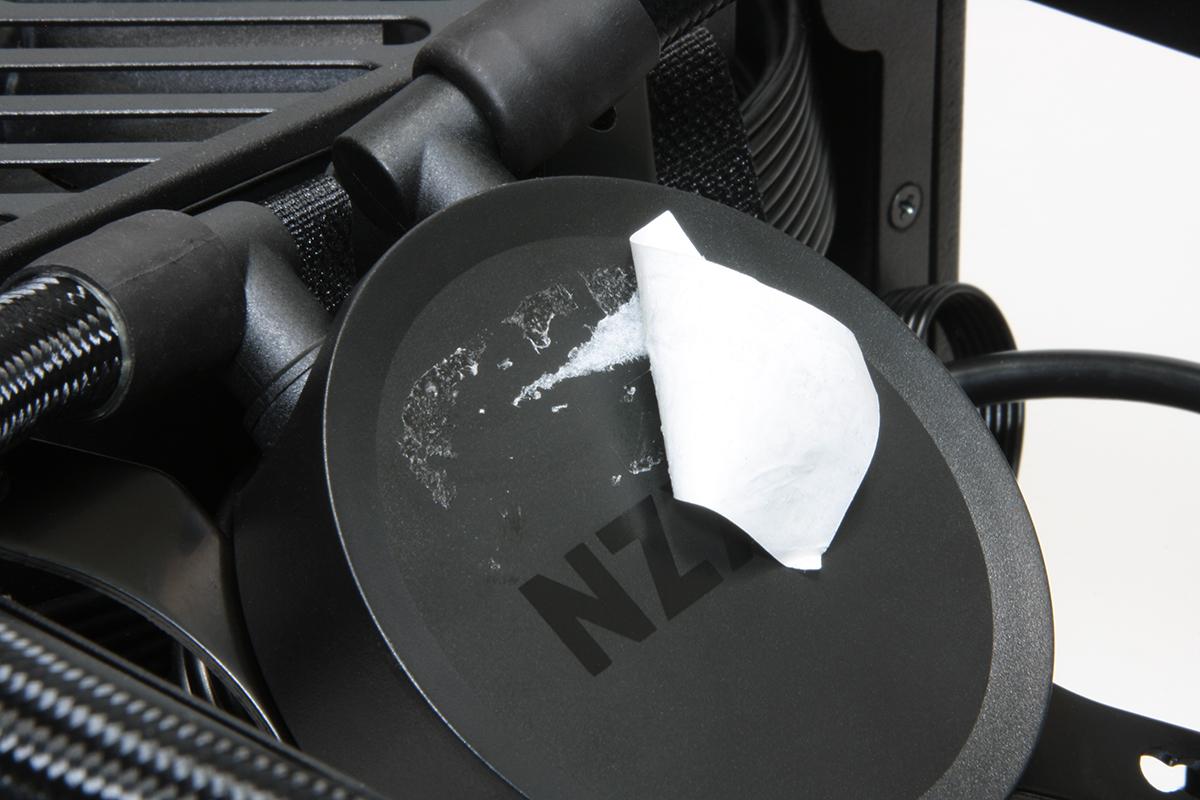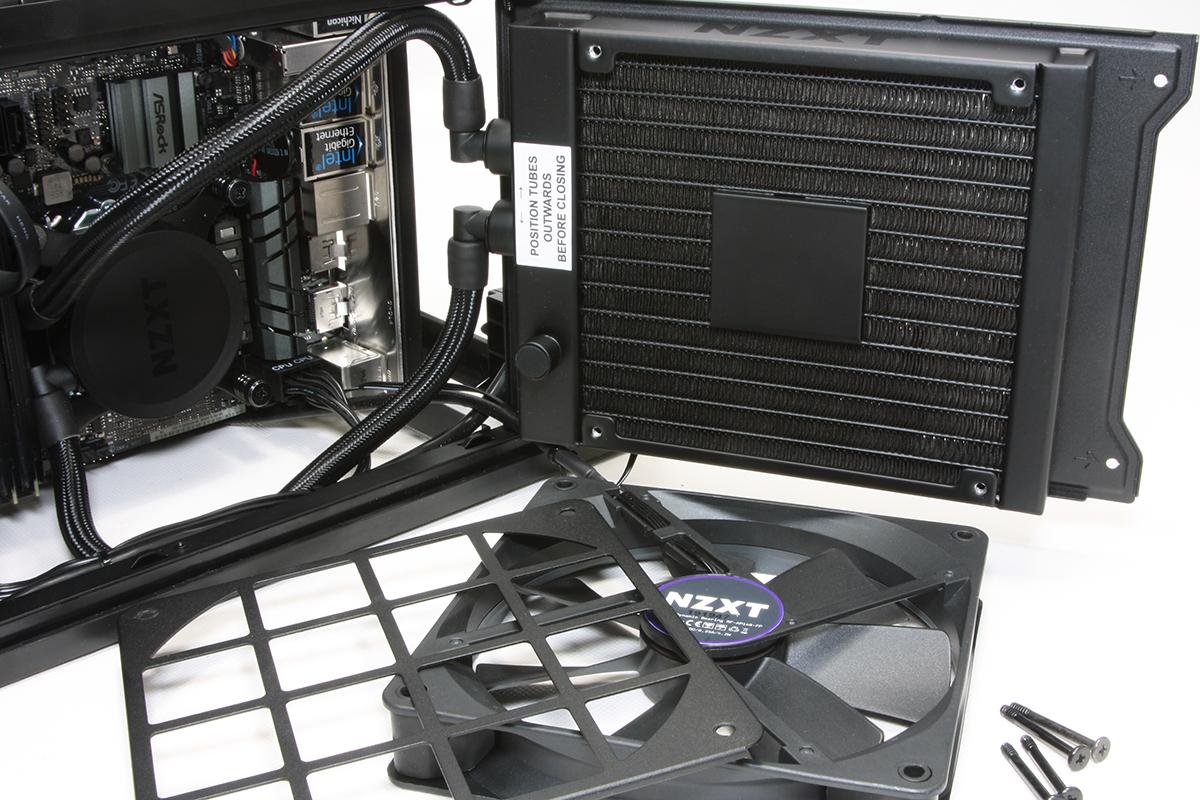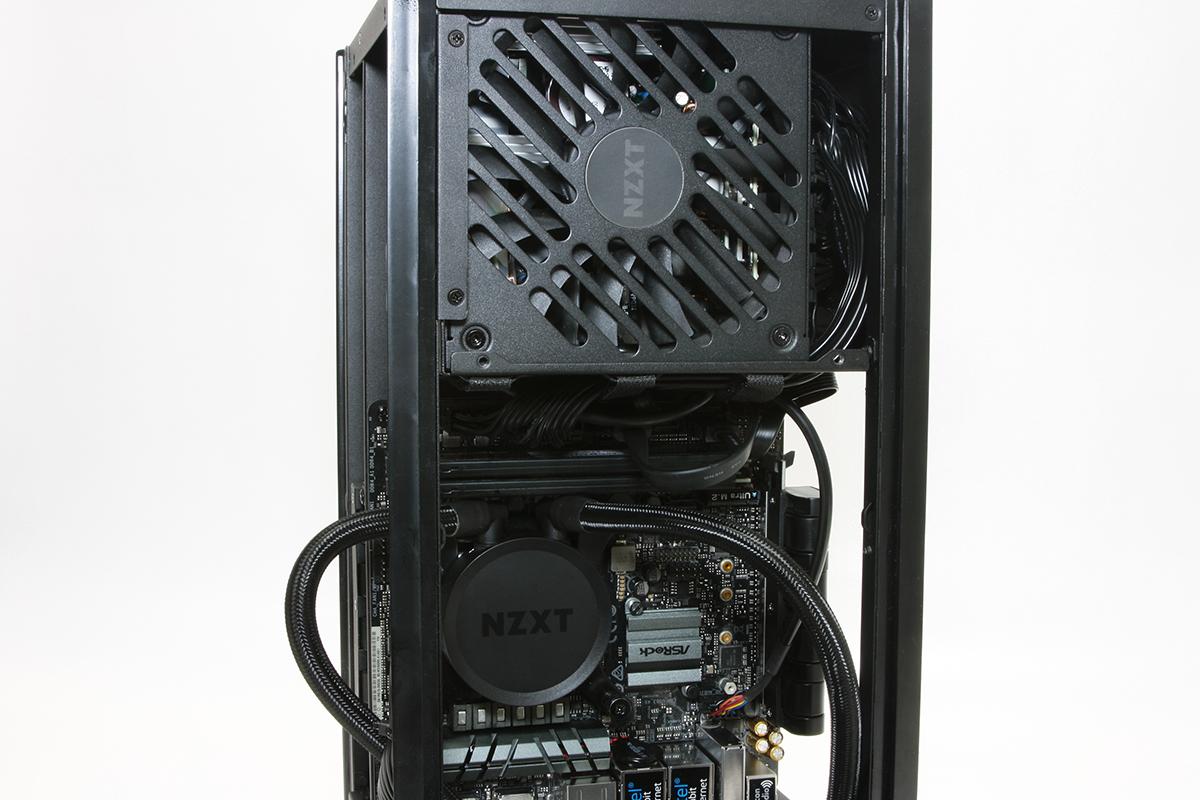Tom's Hardware Verdict
Simplistic, monolithic design and the capability to spec out an surprisingly powerful PC (gaming, workstation or otherwise) makes the NZXT H1 a solid choice for someone seeking full desktop potential with a very modest footprint.
Pros
- +
Easy installation of hardware
- +
Includes 650w SFX PSU and 140mm AIO liquid cooling
- +
Compact footprint
Cons
- -
Supports only mITX motherboards
- -
No support for additional fans
Why you can trust Tom's Hardware
NZXT’s new ultra-compact H1 mITX chassis arrives equipped with both a 650w, 80+ Gold SFX modular power supply and built-in NZXT 140mm AIO liquid cooling, making it incredibly attractive for system builders looking to assemble a tiny but powerful desktop PC. Simply drop in your choice of mITX motherboard, 2.5-inch SSD/HDD (or a motherboard-mounted NVMe drive) and system memory (and a graphics card if you’re a gamer), and the NZXT H1 becomes a quiet, compact machine. With support for all but the largest of GPUs, the H1 can also be built up as a powerful gaming monster.
Priced at $349, the H1 seems pricey, until you stop to factor in the cost of a quality AIO cooler and SFX-L PSU. Taken together with the attractive chassis, there’s a surprising level of value here, which is why it made our best cases list under the mini-ITX category.
Specifications
| Form Factor | Ultra Compact Desktop |
|---|---|
| Motherboard Support | mITX |
| Connectivity | 1x USB-C, 1xUSB-A, 1x 4-pole audio jack |
| Dimensions | 388mm x 187mm x 187mm |
| Graphics Card Clearance | 305mm (length), 2.5 slot PCIe |
| Drives Supported | 2.5-inch (2x) |
| Fans Supported | 140mm (1x - on radiator) |
| Radiator Support | 140mm (1x) |
| Warranty | 3 Years (case + cooling), 10 years (PSU) |
| Web Price | $349 |
Features
As small form-factor (SFF) cases go, the H1 delivers a simple, monolithic look snf minimalist appeal. At 187mm x 187mm (7.36 x 7.36 inches square), it occupies a tiny amount of desk or floor space, while allowing for system builds which rival large gaming PCs. Combine this with a very perferated set of side panels, the H1 allows for access to fresh air for the 140mm AIO as well as allowing easy venting of the thermal load.
Top panel access is clean and concise, with an LED-lit power switch and a single item each of USB-C, USB-A and a 4-pole audio I/O jack.
The NZXT H1 ships with all components nested neatly within its rectangular frame, including the installed 650w power supply and PCI-e graphics card riser. Cabling is neatly bundled and already routed throughout the chassis, making cable management an afterthought even before assembly.
Included accessories are focused around AIO cooler mounting for AMD AM4, FM2(+), FM1, AM3(+), AM2 and Intel 115x. An included headphone/mic splitter makes for easy addition for audio I/O from the top panel, instead of routing 3.5mm connections to the bottom of the motherboard panel.
Getting to the interior of the H1 requires both the tempered glass front panel and mesh rear panel to be popped off to unlock the singular, U-shaped side+top cover of the chassis. Side rails allow for the top/side panel to slide neatly up and off of the chassis, and provide guidance when sliding them back down into position during reassembly. Magnetic, removable mesh dust filters extend along the interior length of both side panels.
Get Tom's Hardware's best news and in-depth reviews, straight to your inbox.
The 140mm AIO comes with a splotch of pre-applied thermal compound on the plate, and the radiator is mounted on a swing-out frame that allows for simple access to the motherboard mounting platform.
Stubborn stickers are unfortunately found on multiple components of the H1, which tend to leave a lot of adhesive mess upon removal. A bit of adhesive remover was required to tidy this up, but we’d like to see a better approach to providing information to the buyer/builder than stickers that wind up looking like the above when you attempt to remove them. We would also like to caution that a good amount of pressure and rubbing was required when removing the gunk, which could cause damage to components if you aren’t careful.
Even though the H1 supports only the small, mini-ITX motherboard form factor, it feels like there’s a good amount of space to move about inside the chassis during installation of components. A relocated PSU power cable allows for the 120v power to be relocated to the rear/bottom of the chassis, along with the motherboard I/O panel.
Below the motherboard sits the PCI-e graphics card riser mount, which wraps around to the opposite side and allows for the riser to be fitted into the PCI-e slot. There is ample room for all but the very largest graphic cards on the market, allowing for the H1 to pack as much graphics card power into a highly portable build.
Closely resembling the Kraken M22, the 140mm AIO in the H1 has the pump mounted in the center of the radiator, leaving the mounted component to function only as a CPU block.
Swivel fittings allow sweeping the sleeved tubing out and away from the CPU when the radiator and fan are swung back into mounting position. Since the 140mm AIO pivots down to sit adjacent to the CPU block face, rotating the cooler’s tubing is required to close up the chassis. Use care when performing this step though, as it still requires focus to correctly orient the tubing while also not pinching it or the fan/pump wiring between the chassis pivot hinge in the process.
Once the motherboard is installed and the cooler cold plate is mounted, closing up the H1 shows just how compact a complete system build can be. The layout and preparation of the cabling, cooler and drives resembles a densely complex puzzle of components. Seeing the close proximity of all the components, it’s easy to see why the correct positioning of the coolant tubing is needed to complete the electronics origami inside the H1.
The bottom of the H1 aligns the motherboard I/O panel, graphics card ports and relocated power supply connection in a convenient cavity and routing arch cutaway. As the H1 is designed to stand vertically, the lower cutaway provides Ethernet, USB, display and power cabling to collect and direct out the bottom rear of the H1 chassis.

Garrett Carver is a contributor for Tom’s Hardware, primarily covering thermal compound comparisons and CPU cooling reviews; both air and liquid, including multiple variations of each.
-
digitalgriffin So about:Reply
~$80 AIO cooler
~$120 for the power supply. I might go $140 because of the 10 year warranty and it's SFX.
That's about $200. $360 - $200 = $140->$160 case. That's a bit pricey. -
Pat Flynn Really wish they'd factored in the option of cooling the GPU with water as well. Pretty sure the radiator wouldn't handle both, but it seems like GPU liquid cooling always takes a back stage to CPU's, when the high end GPU's always put out more heat than CPUs in the mid line platforms.Reply -
vinyfiny Reply
I think GPU liquid cooling mostly gets overlooked because there's very few factory liquid cooled GPU's, and it's much more difficult to add a liquid cooler to an air cooled GPU. Using an AIO on a CPU is typically as easy as installing an air cooler.Pat Flynn said:Really wish they'd factored in the option of cooling the GPU with water as well. Pretty sure the radiator wouldn't handle both, but it seems like GPU liquid cooling always takes a back stage to CPU's, when the high end GPU's always put out more heat than CPUs in the mid line platforms. -
vinyfiny Reply
It's honestly a decent price for a premium, unique ITX case that's ACTUALLY small (aka not something like the H210). Custom layouts like this tend to be more expensive to manufacture because existing tooling/parts/techniques can't be used, and money has to be spent on R&D. The H210 is $80 because it's a scaled version of an existing case.digitalgriffin said:So about:
~$80 AIO cooler
~$120 for the power supply. I might go $140 because of the 10 year warranty and it's SFX.
That's about $200. $360 - $200 = $140->$160 case. That's a bit pricey.
Also don't forget the included riser card which is probably worth another $40-$60. Realistically the H1 is a $100 case which I think is perfectly reasonable (honestly it's kind of cheap). Now if they could just replace that front TG with another mesh panel... -
ABlazinBlueToe Replydigitalgriffin said:So about:
~$80 AIO cooler
~$120 for the power supply. I might go $140 because of the 10 year warranty and it's SFX.
That's about $200. $360 - $200 = $140->$160 case. That's a bit pricey.
A bit, although sfx cases usually seem to come at a premium. -
digitalgriffin Replyvinyfiny said:It's honestly a decent price for a premium, unique ITX case that's ACTUALLY small (aka not something like the H210). Custom layouts like this tend to be more expensive to manufacture because existing tooling/parts/techniques can't be used, and money has to be spent on R&D. The H210 is $80 because it's a scaled version of an existing case.
Also don't forget the included riser card which is probably worth another $40-$60. Realistically the H1 is a $100 case which I think is perfectly reasonable (honestly it's kind of cheap). Now if they could just replace that front TG with another mesh panel...
Riser cards are $15. The market is flooded with them due to miners, and plenty of ITX cases already have them included.
For example, the Fractal Designs Node 202 is commonly $80 and includes a riser card. And it's smaller than this. (Although I must admit, not as stylish)
I can see NZXT cashing in on the fact this looks like the proposed new XBox -
junglist724 Replyvinyfiny said:Now if they could just replace that front TG with another mesh panel...
Seriously, that's the only thing that caused me to lose interest in the case. The glass isn't showing off anything interesting, and it's blocking gpu exhaust for open air gpus. -
rubix_1011 The panels of the case are well ventilated due to the excessive vents in the mesh.Reply
In theory, the front tempered glass could be replaced by the rear mesh panel - they are identical in size, if I recall, making them interchangeable. So, you could simply swap the front and rear panels if you wished. Otherwise, perhaps NZXT will release a model that does not have the glass front and a mesh panel instead.
Overall, I did like the case, although the layout does not leave much space for additional components or cabling.
The graphics card relocation is very nice and providing room for all but the largest GPUs (3x PCIe or extended length cards might not fit).
What makes GPU liquid cooling difficult is the difference in PCB layout and TDP requirements per card, per vendor, per SKU. GPUs also tend to have a higher TDP than most CPUs, but conversely, also seem to respond very well to liquid cooling - drops in 20-30C under load are common, but again, depends on method and actual liquid cooling being used. -
mlee 2500 I used to build SFF. Then I realized that consuming ~25% more surface or floor space wasn't really an issue for me, and that I could far more easily build a quieter machine using a larger radiator with larger and more slowly rotating fans. To say nothing of the wider range of parts available for a normal sized chassis.Reply
I'm much happier now. -
mlee 2500 Replydigitalgriffin said:So about:
~$80 AIO cooler
~$120 for the power supply. I might go $140 because of the 10 year warranty and it's SFX.
That's about $200. $360 - $200 = $140->$160 case. That's a bit pricey.
Yeah, if you want a larger selection of compatible parts and the more competitive pricing that comes with that then SFF usually isn't the route to take. I certainly never saved any money building that form factor, and in fact it usually entails substantial compromise.
In my experience the smaller footprint really only pays dividends with less performance sensitive commodity applications, like plopping them down on lab benches or in business offices.












